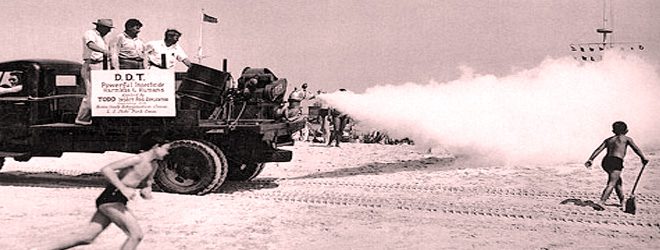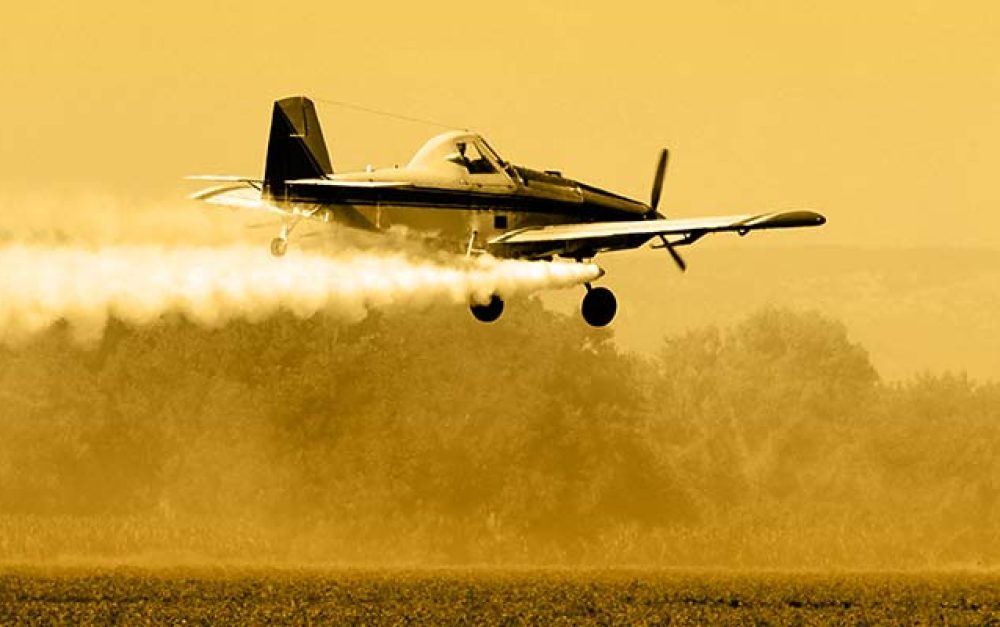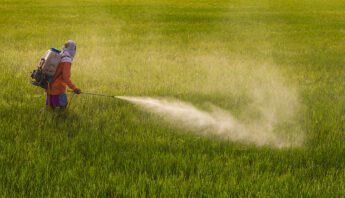If there is a single pesticide almost everyone can name, it’s DDT.
DDT was one of the first chemicals in widespread use as a pesticide. Following World War II, it was promoted as a wonder-chemical, the simple solution to pest problems large and small. Today, nearly 40 years after DDT was banned in the U.S., we continue to live with its long-lasting effects:

- Food supplies: USDA found DDT breakdown products in 60% of heavy cream samples, 42% of kale greens, 28% of carrots and lower percentages of many other foods.
- Body burden: DDT breakdown products were found in the blood of 99% of the people tested by CDC.
- Health impacts: Girls exposed to DDT before puberty are 5 times more likely to develop breast cancer in middle age, according to the President’s Cancer Panel.
Banned for agricultural uses worldwide by the 2001 Stockholm Convention on Persistent Organic Pollutants, the use of DDT is still permitted in small quantities in countries that need it, with support mobilized for the transition to safer and more effective alternatives. The treatment of DDT under the Stockholm Convention is strongly supported by PAN and our international partners.
 Rachel Carson highlighted the dangers of DDT in her groundbreaking 1962 book Silent Spring. Carson used DDT to tell the broader story of the disastrous consequences of the overuse of insecticides, and raised enough concern from her testimony before Congress to trigger the establishment of the Environmental Protection Agency (EPA).
Rachel Carson highlighted the dangers of DDT in her groundbreaking 1962 book Silent Spring. Carson used DDT to tell the broader story of the disastrous consequences of the overuse of insecticides, and raised enough concern from her testimony before Congress to trigger the establishment of the Environmental Protection Agency (EPA).
Her work attracted outrage from the pesticide industry and others. Her credibility as a scientist was attacked, and she was derided as “hysterical,” despite her fact-based assertions and calm and scholarly demeanor. Following the hearings, President Kennedy convened a committee to review the evidence Carson presented. The committee’s review completely vindicating her findings.
One of the new EPA’s first acts was to ban DDT, due to both concerns about harm to the environment and the potential for harm to human health. There was also evidence linking DDT with severe declines in bald eagle populations due to thinning eggshells. Since DDT was banned in the U.S., bald eagles have made a dramatic recovery.
Recently, Carson’s work has again been targeted by conservative groups. Capitalizing on the iconic status of DDT, these groups are promoting widespread use of the chemical for malaria control as part of a broader effort to manufacture doubt about the dangers of pesticides, and to promote their anti-regulatory, free market agenda while attempting to undermine and roll back the environmental movement’s legacy.
Many DDT promoters are also in the business of denying climate change.
Attacks on Carson from groups like The Competitive Enterprise Institute and Africa Fighting Malaria portray DDT as the simple solution to malaria, and blame Carson for “millions of deaths in Africa.” Many of these DDT promoters are also in the business of denying climate change and defended the tobacco industry by denying the health harms of smoking.
Human Health Harms
The science on DDT’s human health impacts has continued to mount over the years, with recent studies showing harm at very low levels of exposure. Studies show a range of human health effects linked to DDT and its breakdown product, DDE:
- breast & other cancers
- male infertility
- miscarriages & low birth weight
- developmental delay
- nervous system & liver damage
No ‘Silver Bullet’ for Malaria Control
The only remaining legal use of DDT is to control malaria-carrying mosquitoes. A devastating disease, malaria kills more than 800,000 people every year, the majority of deaths among children in Sub-Saharan Africa. Indoor spraying with DDT is one of a number of tools being used to control malaria around the world. Only in rare cases is it the most effective choice.
Successful malaria control programs have been built all over the world using a variety of approaches that are affordable and appropriate to local needs. All include community involvement, appropriate technology and investment in public health capacity and education. These community-based, integrated solutions have proven successful in places as diverse as Mexico, Kenya and Vietnam.
Unfortunately, vocal groups such as Africa Fighting Malaria continue to promote a simplistic “DDT or nothing” debate, ignoring on-the-ground evidence from around the world that more effective approaches are saving lives without putting communities in harm’s way from exposure to the long-lasting chemical.
PAN works with international allies, governments and on-the-ground groups in Africa to mobilize resources and political will to combat malaria, and remains active in international legal processes to support the global phase out of DDT and promote the safest and most effective malaria control solutions.







